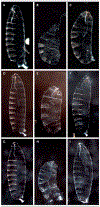Effect of Genetic Diagnosis on Patients with Previously Undiagnosed Disease
- PMID: 30304647
- PMCID: PMC6481166
- DOI: 10.1056/NEJMoa1714458
Effect of Genetic Diagnosis on Patients with Previously Undiagnosed Disease
Abstract
Background: Many patients remain without a diagnosis despite extensive medical evaluation. The Undiagnosed Diseases Network (UDN) was established to apply a multidisciplinary model in the evaluation of the most challenging cases and to identify the biologic characteristics of newly discovered diseases. The UDN, which is funded by the National Institutes of Health, was formed in 2014 as a network of seven clinical sites, two sequencing cores, and a coordinating center. Later, a central biorepository, a metabolomics core, and a model organisms screening center were added.
Methods: We evaluated patients who were referred to the UDN over a period of 20 months. The patients were required to have an undiagnosed condition despite thorough evaluation by a health care provider. We determined the rate of diagnosis among patients who subsequently had a complete evaluation, and we observed the effect of diagnosis on medical care.
Results: A total of 1519 patients (53% female) were referred to the UDN, of whom 601 (40%) were accepted for evaluation. Of the accepted patients, 192 (32%) had previously undergone exome sequencing. Symptoms were neurologic in 40% of the applicants, musculoskeletal in 10%, immunologic in 7%, gastrointestinal in 7%, and rheumatologic in 6%. Of the 382 patients who had a complete evaluation, 132 received a diagnosis, yielding a rate of diagnosis of 35%. A total of 15 diagnoses (11%) were made by clinical review alone, and 98 (74%) were made by exome or genome sequencing. Of the diagnoses, 21% led to recommendations regarding changes in therapy, 37% led to changes in diagnostic testing, and 36% led to variant-specific genetic counseling. We defined 31 new syndromes.
Conclusions: The UDN established a diagnosis in 132 of the 382 patients who had a complete evaluation, yielding a rate of diagnosis of 35%. (Funded by the National Institutes of Health Common Fund.).
Figures

References
-
- Gahl WA, Wise AL, Ashley EA. The Undiagnosed Diseases Network of the National Institutes of Health: a national extension. JAMA 2015;314:1797–8. - PubMed
-
- The Undiagnosed Diseases Network home page (https://gateway.undiagnosed.hms.harvard.edu/static/start.html).
Publication types
MeSH terms
Grants and funding
- U01 HG007690/HG/NHGRI NIH HHS/United States
- U01 HG007708/HG/NHGRI NIH HHS/United States
- U01 HG007674/HG/NHGRI NIH HHS/United States
- U01 HG007672/HG/NHGRI NIH HHS/United States
- R01 GM113230/GM/NIGMS NIH HHS/United States
- U01 HG007943/HG/NHGRI NIH HHS/United States
- R01 HG011795/HG/NHGRI NIH HHS/United States
- U01 HG007703/HG/NHGRI NIH HHS/United States
- U01 HG007942/HG/NHGRI NIH HHS/United States
- U01 HG010218/HG/NHGRI NIH HHS/United States
- U01 TR001395/TR/NCATS NIH HHS/United States
- U01 HG007709/HG/NHGRI NIH HHS/United States
- U54 NS093793/NS/NINDS NIH HHS/United States
- U01 HG007530/HG/NHGRI NIH HHS/United States
LinkOut - more resources
Full Text Sources
Medical
Molecular Biology Databases
